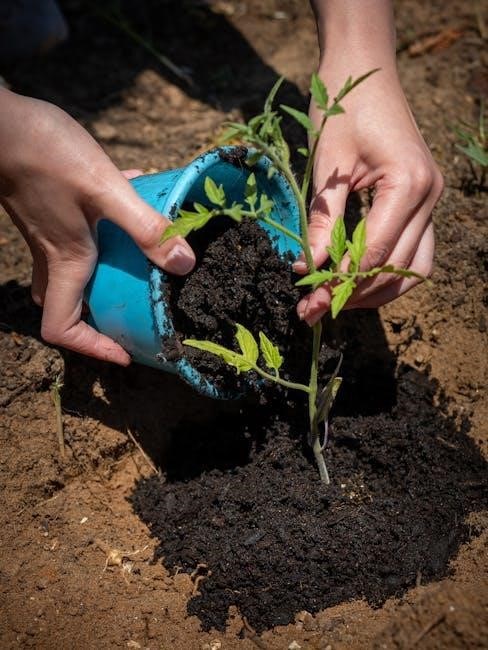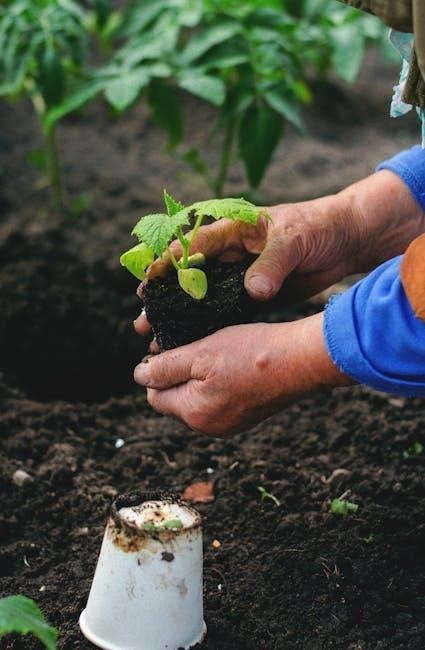Australia’s diverse climate zones make vegetable planting a rewarding yet challenging task. This guide provides tailored advice for gardeners across regions, ensuring optimal growth and harvest success.
Purpose and Scope
This guide aims to assist Australian gardeners in successfully planting and growing vegetables. It covers climate-specific advice, seasonal planting calendars, and essential gardening tips. Designed for both beginners and experienced gardeners, the guide addresses soil preparation, pest management, and crop rotation. It focuses on Australia’s diverse regions, including temperate, subtropical, and arid zones. The scope includes practical strategies for maximizing yields and maintaining soil health. By following this guide, gardeners can enjoy productive and sustainable vegetable gardens year-round.

Climatic Zones in Australia
Australia’s diverse climate ranges from tropical to arid, significantly influencing vegetable planting strategies. Understanding these zones is crucial for selecting appropriate crops and timing plantings effectively nationwide.
Temperate Zone
The temperate zone in Australia experiences mild winters and warm summers, making it ideal for growing a wide variety of vegetables. Popular choices include broccoli, spinach, carrots, and beetroot, which thrive in cooler conditions. In summer, tomatoes, zucchini, and cucumbers are common. Spring and autumn are perfect for planting peas, lettuce, and radishes. The moderate climate allows for year-round gardening by selecting seasonal varieties. This zone’s diverse growing conditions make it a favored region for backyard vegetable gardens, offering consistent and rewarding harvests for gardeners of all skill levels.
Subtropical Zone
The subtropical zone in Australia is characterized by warm winters and hot, humid summers. This climate is suitable for growing vegetables like tomatoes, capsicums, and chillies, which thrive in heat. Root vegetables such as sweet potatoes and ginger also perform well. However, extreme heat requires shade protection for sensitive crops. Regular watering and well-draining soil are essential to prevent waterlogging. The subtropical climate supports year-round vegetable production, but gardeners must manage humidity-related pests and diseases, ensuring good air circulation and soil health for optimal growth.
Tropical Zone
The tropical zone in Australia, characterized by high temperatures and humidity, is ideal for growing heat-tolerant vegetables. Sweet potatoes, ginger, and leafy greens thrive in these conditions. However, the wet season poses challenges like waterlogging and fungal diseases. To mitigate this, ensure good drainage and consider raised beds. Pest management is crucial due to the prevalence of insects in humid climates. Proper spacing and natural repellents can help maintain plant health. Regular monitoring and adaptive watering techniques are essential to optimize growth and prevent common pitfalls like overwatering.
Arid Zone
The arid zone in Australia is characterized by extreme heat, low rainfall, and high evaporation rates. Growing vegetables here requires careful selection of drought-tolerant varieties like tomatoes, capsicum, and zucchini. Soil preparation is critical, with mulching and deep watering essential to retain moisture. Shade cloth can protect plants from intense sunlight, while drip irrigation ensures efficient water use. Planting during cooler parts of the day and choosing fast-maturing varieties can enhance success in this challenging environment.
Seasonal Planting Guide
This guide optimizes vegetable planting based on Australia’s distinct seasons, ensuring crops thrive in summer, autumn, winter, and spring, adapting to regional climate conditions.
Summer Planting
Summer is ideal for growing heat-tolerant vegetables like tomatoes, zucchini, eggplant, capsicum, and okra. Plant beans and corn early in the season for optimal growth. In warmer climates, ensure soil remains moist but well-drained to prevent root rot. Mulching helps retain moisture and suppress weeds. For tropical regions, consider planting dwarf varieties to manage space and heat stress. Keep an eye out for pests like aphids and whiteflies, and water deeply in the morning to avoid evaporation. Proper staking supports tall plants like tomatoes and peas for better yields.
Autumn Planting
Autumn is a great time to plant cool-season vegetables like broccoli, spinach, carrots, and beetroot. In temperate zones, plant brassicas, peas, and onions before the first frost. Soil preparation is key—add compost to improve fertility and drainage. Water deeply but avoid overwatering, as cooler weather reduces evaporation. In subtropical regions, plant leafy greens and herbs. Protect seedlings from slugs and snails. Autumn planting ensures a fresh harvest before winter, offering a rewarding transition between seasons.
Winter Planting
In Australia, winter is ideal for planting cool-season crops like spinach, kale, and broccoli. Root vegetables such as carrots, beetroot, and radishes thrive in temperate zones. In subtropical areas, plant hardy greens and herbs. Soil preparation is crucial—add compost to enhance fertility. Water deeply once or twice a week, as evaporation slows in cooler months. Protect plants from frost and pests. Winter planting ensures a fresh harvest by spring, maintaining garden productivity year-round. It also reduces weed growth and watering needs compared to summer.
Spring Planting
Spring is an ideal time to plant warm-season vegetables in Australia; Popular choices include tomatoes, cucumbers, zucchini, and herbs like basil and mint. Soil preparation is key—add compost or well-rotted manure to improve fertility. Water regularly as the weather warms up, aiming for consistent moisture. Sow seeds directly into the ground, as the soil is now warm enough for germination. Spring planting allows for a bountiful harvest before the heat of summer. It’s also a great time to plant legumes and root vegetables like carrots and radishes. Proper planning ensures a thriving garden.

Choosing the Right Vegetables
Choosing the right vegetables involves considering climate, season, personal taste, and space. Select varieties suited to your region and growing conditions for optimal results.
Popular Vegetables in Australia
Australia’s climate supports a wide variety of vegetables. Tomatoes, cucumbers, and leafy greens like lettuce and spinach are staples in many gardens. Root vegetables such as carrots, potatoes, and beetroot thrive in temperate regions, while zucchini, capsicum, and eggplant are popular in warmer climates. Herbs like basil and mint also grow well. These vegetables are adaptable to different growing conditions and are widely cultivated across the country, making them ideal for home gardens.
Factors to Consider When Selecting Varieties
When selecting vegetable varieties, consider climate, maturity period, and disease resistance. Choose varieties suited to your region’s temperature and rainfall patterns. Maturity time is crucial for aligning harvests with seasonal conditions. Disease-resistant varieties reduce pest and disease risks. Additionally, select based on intended use, such as fresh eating, cooking, or storage. Hybrid and heirloom options offer different benefits, with hybrids often providing higher yields and heirlooms offering unique flavors. Ensure variety selection aligns with your garden’s specific conditions for optimal growth and productivity.
Soil Preparation
Soil preparation is crucial for optimal vegetable growth, involving testing pH levels, adding organic matter, and ensuring proper drainage to create a fertile, well-structured base.
Essential Steps for Soil Preparation
Start by testing the soil pH and adjusting it if necessary, as most vegetables prefer a slightly acidic to neutral range (6.0–7.0). Add organic matter like compost or well-rotted manure to improve soil fertility and structure. Remove debris, rocks, and weeds to create a clean planting area. Till the soil to a depth of 20–30 cm to loosen and aerate it, promoting root growth. Level the ground to ensure even water distribution and prevent pooling. Allow the soil to settle for a few days before planting to stabilize the structure.
Importance of Soil Health
Healthy soil is the foundation of a thriving vegetable garden, providing essential nutrients, water, and support for root growth. It promotes beneficial microbial activity, enhancing nutrient absorption and disease resistance. Good soil health reduces the need for synthetic fertilizers and pesticides, fostering sustainable gardening. Additionally, it improves water retention, mitigates erosion, and supports biodiversity. Healthy soil also sequesters carbon, contributing to climate change mitigation. Investing in soil health ensures robust plant growth, higher yields, and a more resilient garden ecosystem.

Planting Techniques
Proper planting techniques ensure optimal growth, including spacing, timing, and soil preparation. Depth and water placement vary by crop, with climate considerations essential for success.
General Planting Techniques
Proper planting techniques are crucial for successful vegetable gardening in Australia. Start by preparing well-draining soil and ensuring optimal sunlight exposure. Sow seeds at the correct depth, as specified on the seed packet, and maintain adequate spacing between plants to prevent overcrowding. Water gently but thoroughly after planting and keep the soil consistently moist during the germination period. Timing is also critical, with planting often aligned with seasonal weather patterns. Proper labeling and mulching around plants can enhance growth and reduce weed competition, ensuring a healthy start for your vegetables.
Specific Techniques for Different Vegetables
Different vegetables require tailored planting techniques for optimal growth. For tomatoes, plant deeply to the first true leaves and provide stakes for support. Root vegetables like carrots and beets benefit from loose, fine soil to prevent forking. Leafy greens such as lettuce and spinach thrive in consistent moisture and partial shade. Climbing vegetables like peas and beans need sturdy trellises, while vining plants like cucumbers and melons should be trained on mulched beds. Herbs such as basil and mint require regular pruning to encourage bushy growth. Tailoring methods ensures variety-specific success in Australian gardens.

Watering and Irrigation
Vegetables need consistent moisture for healthy growth, requiring about 2.5 cm of water weekly. Water deeply to encourage strong root development, avoiding overwatering to prevent root rot.
Watering Needs of Vegetables
Vegetables require consistent moisture for optimal growth, with most needing 2.5 cm of water weekly. Water deeply to promote strong root systems, but avoid overwatering, which can lead to root rot. Soil type influences water retention; sandy soils drain quickly, while clay soils hold water longer. Water in the early morning or late afternoon to reduce evaporation. Overwatering is common, so check soil moisture by digging a small hole. Mulching helps retain soil moisture and reduce watering frequency.
Efficient Irrigation Methods
Efficient irrigation methods are crucial for water conservation and healthy plant growth. Drip irrigation systems deliver water directly to roots, minimizing evaporation and runoff. Soaker hoses are another effective option, releasing water slowly into the soil. Rainwater tanks are highly recommended in Australia, providing a sustainable water source. Timing irrigation during early morning or late afternoon reduces evaporation. Avoid overhead sprinklers, which can waste water and promote fungal diseases. Using mulch alongside irrigation helps retain soil moisture and reduces watering frequency.

Pest and Disease Management
Regular inspections, organic controls, and maintaining soil health are key to managing pests and diseases. Encourage beneficial insects and use natural predators to reduce chemical reliance.
Common Pests in Australian Gardens
Australian gardens face pests like aphids, caterpillars, slugs, and snails, which target vegetables. Native insects, such as grasshoppers and Christmas beetles, can also damage crops. Spider mites thrive in dry climates, while whiteflies and nematodes affect specific plants. Regular monitoring and early intervention are essential to prevent infestations. Understanding pest life cycles helps in applying targeted controls, ensuring healthier plants and higher yields in vegetable gardens across Australia’s diverse regions.
Organic Pest and Disease Control Methods
Organic methods are effective for managing pests and diseases in Australian vegetable gardens. Companion planting, like marigolds for nematodes and nasturtiums for aphids, naturally deters pests. Neem oil and diatomaceous earth are safe, non-toxic options for controlling insects. Crop rotation prevents soil-borne diseases, while introducing beneficial insects, such as ladybugs and parasitic wasps, balances ecosystems. Organic fungicides like bicarbonate solutions and garlic sprays also help control fungal diseases. Regular monitoring ensures early intervention, promoting a healthy, sustainable garden environment.
Crop Rotation and Intercropping
Crop rotation and intercropping are essential practices in Australian vegetable gardening. They enhance soil health, reduce pests, and optimize space, ensuring a diverse and productive garden.
Benefits of Crop Rotation
Crop rotation improves soil fertility, reduces erosion, and breaks pest and disease cycles. It enhances nutrient availability, promotes beneficial microorganisms, and increases crop diversity. By alternating plants, gardeners can optimize space, reduce pesticide use, and maintain a balanced ecosystem. This practice also prevents soil degradation and supports biodiversity, ensuring long-term garden health and productivity in Australian climates.
Effective Intercropping Practices
Intercropping maximizes space and enhances growth by planting complementary vegetables together. It improves soil health, reduces pests, and boosts yields. For example, planting marigolds with tomatoes deters nematodes, while basil repels aphids from lettuce. Tall plants like sunflowers can shade smaller crops like lettuce, reducing soil temperature. Ensure proper spacing and timing to avoid competition for resources. This method promotes biodiversity, optimizes garden productivity, and creates a balanced ecosystem for thriving vegetables in Australian gardens.
Mulching
Mulching retains moisture, suppresses weeds, and regulates soil temperature. Apply a 5-10 cm layer, keeping it away from plant stems. It keeps roots cool, prevents erosion, and enriches soil as it breaks down over time.
Types of Mulch Suitable for Vegetables
Organic mulches like straw, bark chips, grass clippings, and leaves are ideal for vegetable gardens. Straw is lightweight and weed-suppressive, while bark chips improve soil structure. Grass clippings add nitrogen, and shredded leaves enrich the soil. Compost-based mulches promote healthy microbial activity. Avoid using mulches like pine needles, as they can acidify the soil. Apply mulch evenly, keeping it a few centimeters away from plant stems to prevent rot. These options retain moisture, regulate temperature, and enhance soil fertility.
Benefits of Mulching in Vegetable Gardens
Mulching offers numerous benefits for vegetable gardens, including moisture retention, weed suppression, and soil temperature regulation; It reduces evaporation, ensuring plants receive consistent water supply, especially in Australia’s dry climate. Mulch acts as a barrier, preventing weeds from competing for nutrients. As it breaks down, it enriches the soil with organic matter, improving fertility and structure. This promotes healthy root growth and supports beneficial microbes, leading to robust and productive vegetable plants. Regular mulching is a simple yet effective practice for thriving gardens.

Support Structures
Support structures like stakes, trellises, and cages help vegetables grow upright, saving space and promoting healthy growth. Ideal for tomatoes, peas, and climbing plants, they enhance yields and accessibility.
Common Support Structures for Vegetables
Common support structures include stakes, trellises, cages, and arbors. Stakes are ideal for upright plants like tomatoes, while trellises suit climbing vegetables such as peas and beans. Cages provide sturdy support for plants like eggplants, and arbors are perfect for vining crops such as cucumbers and pumpkins. These structures help optimize space, improve air circulation, and keep plants healthy by preventing them from sprawling on the ground.
Vegetables That Require Support
Several vegetables require support to grow effectively. Tomatoes need stakes or cages to stay upright, while peas and beans benefit from trellises or fences. Cucumbers and zucchini thrive on arbors or wire frames. Pumpkins and melons can be supported with crates or nets to keep them off the ground. Providing the right support ensures proper growth, prevents damage, and makes harvesting easier. Each vegetable has specific needs, so choosing the correct structure is essential for optimal results in an Australian garden.

Fertilization
Fertilization is crucial for healthy vegetable growth in Australian gardens. Balanced fertilizers provide essential nutrients like nitrogen, phosphorus, and potassium. Proper timing and soil testing maximize growth and yields.
Organic Fertilizers for Vegetables
Organic fertilizers like compost, manure, and worm castings are ideal for vegetable gardens. They enrich soil with essential nutrients and improve soil structure. Blood and bone meal, high in nitrogen and phosphorus, promote healthy plant growth. Green manure crops, such as legumes, naturally replenish soil nutrients. These eco-friendly options enhance soil health and ensure sustainable vegetable production. Always apply organic fertilizers during planting or as a top dressing for optimal results. Regular use fosters a fertile and productive garden environment.
Fertilization Schedule for Optimal Growth
A well-planned fertilization schedule is crucial for maximizing vegetable yields. Apply organic fertilizers like compost or manure at planting time and repeat monthly. For rapid-growing crops, a balanced fertilizer can be applied every 2-3 weeks. Side-dress with a high-nitrogen fertilizer during the growth phase. Avoid over-fertilizing, as this can harm plants. Adjust the schedule based on soil test results and the specific needs of your vegetables. Consistent fertilization ensures healthy growth and abundant harvests throughout the growing season.

Harvesting
Harvest vegetables at the optimal time to ensure quality and flavor. Use sharp tools to avoid damage, and handle produce gently to maintain freshness and quality.
Tips for Harvesting Vegetables
- Harvest vegetables at their peak ripeness for optimal flavor and texture.
- Check for size, color, and firmness to determine readiness.
- Use sharp, clean tools to avoid damaging plants or produce.
- Harvest in the early morning for higher water content and freshness.
- Handle produce gently to prevent bruising or spoilage.
- Regular harvesting encourages continuous production in some plants.
- Learn specific techniques for different vegetables, like twisting or cutting.
- Store harvested vegetables in a cool, dry place to extend shelf life.
Signs of Readiness for Harvest
Recognizing when vegetables are ready to harvest ensures optimal flavor and texture. For most vegetables, look for changes in color, size, and firmness. Tomatoes turn from green to their final color, while cucumbers and zucchini reach a usable size without becoming too large. Root vegetables like carrots and beets can be checked by gently digging around the plant. Leafy greens are ready when leaves reach a usable size, and beans snap cleanly when bent. Harvest when produce is tender but firm to avoid spoilage.
Common Mistakes to Avoid
Common mistakes include overwatering, planting too close, insufficient sunlight, poor soil preparation, and neglecting crop rotation. These errors can lead to poor growth, disease, and reduced yields.
- Overwatering causes root rot.
- Inadequate spacing reduces air circulation.
- Incorrect soil pH affects nutrient uptake.
- Not rotating crops depletes soil nutrients.
Mistakes Beginner Gardeners Should Avoid
Beginner gardeners often make avoidable errors that hinder plant growth. Overwatering, insufficient sunlight, and poor soil preparation are common issues. Planting vegetables too close together reduces air circulation, leading to disease. Neglecting to check the specific climate requirements for each plant can result in poor yields. Additionally, not using mulch or compost to enrich the soil can deprive plants of essential nutrients. Starting with too many varieties at once can overwhelm new gardeners, making it difficult to manage the garden effectively. Proper planning and research are key to success.
- Overwatering leads to root rot.
- Incorrect spacing reduces air circulation.
- Skipping soil preparation affects growth.
- Not mulching depletes soil moisture.
Troubleshooting Common Issues
Common issues in vegetable gardening include pests, diseases, and environmental stress. Aphids, caterpillars, and powdery mildew are frequent problems. Overwatering can cause root rot, while underwatering leads to stunted growth. Nutrient deficiencies, such as nitrogen or iron lack, can yellow leaves. Extreme weather like frost or heatwaves can damage plants. Regular monitoring, organic pest control, and timely intervention are essential. Ensuring proper drainage, adequate sunlight, and balanced fertilization helps mitigate these issues. Support structures for climbing plants also prevent damage from wind or weight.
- Check for pests daily to prevent infestations.
- Inspect leaves for nutrient deficiencies.
- Adjust watering schedules seasonally.

Resources and Further Reading
Explore detailed PDF guides on Australian vegetable planting from trusted sources like Gardening Australia and local nurseries. Visit government agricultural websites for region-specific advice and expert tips.
Recommended PDF Guides
Download comprehensive PDF guides from reputable sources like Gardening Australia and state agricultural departments. These resources provide detailed planting calendars, variety recommendations, and care tips tailored to Australia’s climate zones. Guides often include region-specific advice, ensuring optimal growth for your area. Many PDFs are free and accessible online, offering practical insights for both novice and experienced gardeners. Check official government websites or gardening associations for the most reliable and up-to-date information to enhance your vegetable planting success.
Online Resources for Vegetable Planting
Explore trusted online resources like the Australian Government’s Department of Agriculture, Water, and the Environment website, which offers detailed planting guides. Gardening Australia’s official website provides seasonal advice and variety recommendations. State-specific resources, such as NSW Department of Primary Industries, offer regionally tailored tips. Gardening forums and communities, like Gardenate, share planting calendars and expert advice. YouTube channels dedicated to Australian gardening also provide video tutorials and practical tips for successful vegetable cultivation. These resources ensure you have access to reliable, up-to-date information for optimal results.
With the right knowledge and planning, vegetable planting in Australia can be highly rewarding. Understanding climatic zones, seasonal planting times, and soil preparation is key to success. By choosing suitable varieties and implementing sustainable practices like mulching and crop rotation, gardeners can enjoy bountiful harvests. Remember to water wisely, manage pests organically, and provide necessary support for plants. Whether you’re a seasoned gardener or a beginner, this guide equips you with essential insights to thrive in Australia’s diverse conditions. Happy gardening!

